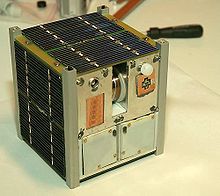Cubesat

CubeSat ( cube , since the basic unit is approximately cube-shaped, see below) is a standard for low-cost small satellites developed in 1999 by Stanford University and California Polytechnic State University .
specification
The satellites must conform to a standard format. The smallest possible Cubesat (1U from English one unit for one unit ) has the dimensions 11.35 cm × 10 cm × 10 cm and a maximum weight of 1.33 kg. These satellites are carried in a special launch device (Poly Picosatellite Orbital Deployer or P-POD), which can accommodate three CubeSats, as a secondary payload during satellite launches. In addition, a launch device for individual CubeSats was developed by the Japanese Titech University.
As an extension of the Cubesat format, there are also one and a half times (1.5U, 17.02 cm × 10 cm × 10 cm, 2 kg), double (2U, 22.7 cm × 10 cm × 10 cm, 2.66 kg) and triple (3U, 34.05 cm × 10 cm × 10 cm, 4 kg) CubeSats possible. There are also satellites with partial sizes from CubeSat, for example AeroCube 6 with 0.5U and Spacebee satellites with 0.25U or 1 / 4U.
Spaceflight Industries' price list already listed prices for the launch of Cubesats in sizes 1U, 3U, 6U and 12U in 2013. The 6U unit has the format 10 cm × 22.63 cm × 34.05 cm and weighs 10 kg. The unit 12U has the format 22.63 cm × 22.63 cm × 34.05 cm and weighs 20 kg. The first 12U Cubesat was launched in June 2016, the first 16U Cubesat in July 2019.
Applications
In 2010, Cubesats were used to monitor the environment as well as to carry out biological experiments or to test new space technology. It is estimated that there were between 35 and 40 cubesats in orbit at the time, around a quarter of which were still functioning.
With the establishment of the Cubesat standard, the miniaturization of electronics and sensors made it possible to carry out not only simple tasks but also scientific experiments with such small satellites. One use case are, for example, experiments that are carried out in series, as is done in the study of biological processes. These depend on several inexpensive starting options.
Commercial applications include observation and remote sensing and are a driver of technical development. In 2014, 76 percent of the Cubesats launched were commercial.
The first application outside of Earth orbit took place in 2018, when two 6-way cubesats of the MarCO type flew parallel to the interplanetary flight of the InSight lander to Mars to support communication during the landing of InSight. With the Artemis 1 mission, eight Cubesat space probes are to be brought to the moon in 2021 , one of which will also land on the moon.
Deorbiting
Since 2011, NASA has carried out several experiments to accelerate the crash of Cubesats after the end of the mission ( deorbiting ). Some manufacturers offer passive devices for deorbiting. Systems similar to a braking parachute can be considered, for example , but also a system with a 30-meter-long conductor that generates an electromagnetic force. As of 2019, the development of such a system is still just beginning.
See also
- List of Cubesat satellites
- Rideshare - simultaneous launch of multiple spacecraft
literature
- Committee on Achieving Science Goals with CubeSats: Achieving Science with CubeSats - Thinking Inside the Box. The National Academies Press, Washington, DC 2016, ISBN 978-0-309-44263-3 , [email protected]
Web links
- CubeSat website (English)
- eoPortal (English)
swell
- ↑ http://space.skyrocket.de/doc_sat/cubesat.htm Gunter's Space Page: CubeSat
- ↑ http://space.skyrocket.de/doc_sdat/spacebee.htm Gunter's Space Page: SpaceBEE
- ↑ Pricing Spaceflight ( Memento from January 14, 2013 in the Internet Archive )
- ↑ Pricing Spaceflight as accessed on August 21, 2019
- ↑ Aoxiang Zhixing . Gunter's Space Page, accessed October 27, 2019.
- ↑ Exolaunch has integrated 28 smallsats for July Soyuz launch . Space Daily, July 3, 2019.
- ↑ Momentus X1 (El Camino Real) . Gunter's Space Page, accessed October 27, 2019.
- ↑ a b Tiny Satellites for Big Science in Astrobiology Magazine astrobio.net on July 12, 2010
- ↑ Achieving Science with CubeSats: Thinking Inside the Box by National Academies of Sciences, Engineering, and Medicine, Division on Engineering and Physical Sciences, Space Studies Board, Committee on Achieving Science Goals with CubeSats at National Academies Press, 2016, in the abstract and on page 55. ISBN 9780309442664
- ↑ Beyond Mars, the Mini MarCO Spacecraft Fall Silent on the NASA website on February 5, 2019
- ↑ Passive Deorbit Systems . NASA study from 2018-2019, accessed on August 22, 2019: "deorbit systems are still in their infancy".

